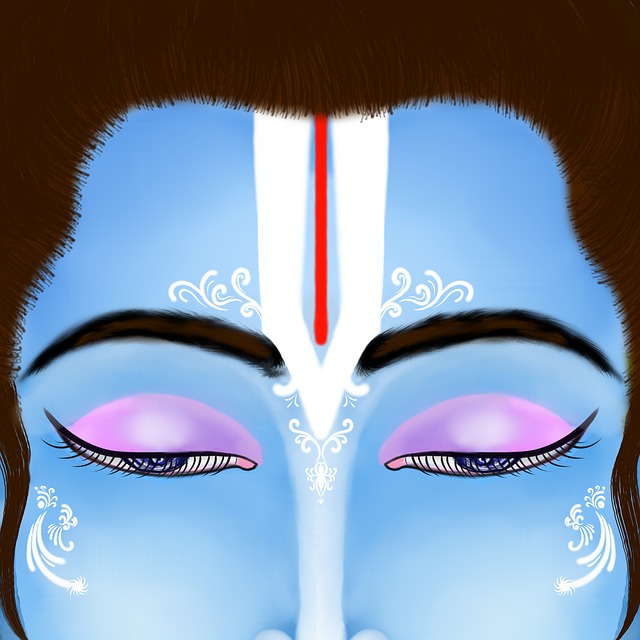 Submitted by Nikhil on
Submitted by Nikhil on

Image by Nikhil Mishra from http://Pixabay.com
“Why is Krishna described in scriptures as black or dark” is far more interesting than the answer to “how did he end up being portrayed as predominantly blue.”
The short answer is he is both black and blue, so it’s ok to paint him blue. However, almost all ancient deities of Krishna are jet black. These deities are much older than any painting. It is also stated in the Bhagavata Purana that he is crystal clear, and that he is lord and source of color (Ranganatha).
Hinduism is so scientific, cosmic and universal that it boggles the mind. Every Hindu God or concept has some parallel in the observable Universe. And even according to modern science, the universe is not all material. In contrast, baryonic or atomic matter makes up a small portion of the mostly dark and seemingly infinite universe.
Lord Krishna while being all-attractive, is also majestically radiant. Vishnu is also known as Surya Narayana, our sun is simultaneously attractive (gravitationally) and radiant, but certainly not black. So then why is Krishna black?
The irony is that the most powerful, massive, energetic and luminous objects in the universe ARE black and supremely attractive.
To find out what and who I’m talking about, you have to journey to the center of the milky way galaxy. Our solar system and billions of other stars, planets etc. are doing “parikrama” around that supremely massive and powerful center, which in its core contains a supermassive black hole and a gravitational singularity (which is really an “infinity”).
The singularity is where Albert Einstein’s Relativity Theory and all our best mathematics break down and reach the “monstrosity” of infinitude… even worse these beloved tools (mathematics and theoretical physics) collapse into recursive infinities while trying to calculate and understand that universal edge-point known as the singularity.
What we know as the vishnu-nabhi, vaikuntha, goloka, abode of Krishna (the supreme center as my guru’s guru would call it) is according to bhagavata cosmology, located in the milky way’s galactic center—what scientists call a “supermassive black hole.” Supermassive black holes are arguably the greatest, most magnificent “things” in our Universe. They are the centers/cores/hearts/atmas/souls of galaxies.
If you study the basics of astrophysics and you have background in any flavor Hinduism (I was raised with Vaishnavism and read Bhagavata Purana for years) then it quickly becomes clear that God or Krishna is not just conceptually supreme, but also represents a universal phenomenon that tends to be supreme in every way you can think of.
Black holes are masters of the universe, essential to the formation of everything, creation, preservation and destruction. Beyond these processes, inside black holes is something which for scientists is completely frustrating—the singularity… infinite nature, infinite curvature, density—and space, time or coordinates have no place inside a singularity.
How can something so black, important and powerful be so tiny and take up precisely zero space? Ask Lord Krishna! He is after all the trickster. In his mouth/stomach Yashoda saw the whole universe before her eyes. Brahma tried to search out his origin being going down the lotus stem into the navel of Vishnu, but he could not find the answer. So he came back up, meditated on it and within his heart the answer finally manifested. That answer is what bhagavata dharma is about, for me at least. Knowing the unknowable partially through the mind, but fully with the heart and acting upon it here on earth. Bhakti Yoga is an amazing system for actualizing this process. There are many wonderful systems, but the original system is the human form itself. Our bodies, minds and hearts are capable of understanding the universe with incredible clarity. The Vedas originated in cosmic sound vibration which ultimately evolved into life.
https://www.quora.com/Why-is-Krishnas-complexion-depicted-as-blue-when-he-is-actually-black
- 435 reads